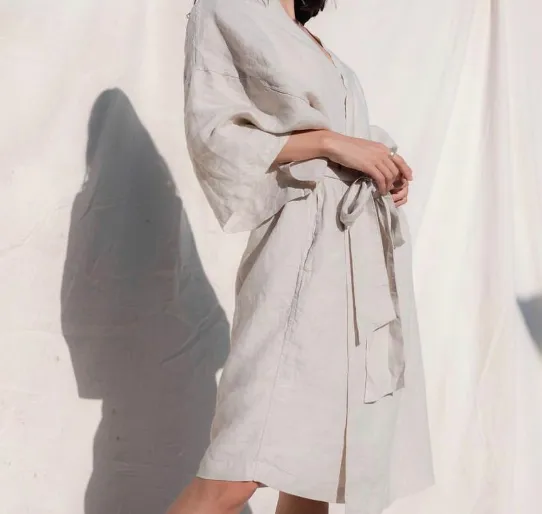Patterned Linen Fabric: The interweaving of tradition and modernity
May . 15, 2025 11:17 Back to list
Patterned Linen Fabric: The interweaving of tradition and modernity
Patterned Linen Fabric, As a textile that combines practicality and aesthetic value, it plays an important role in the long river of history. From ancient Egyptian shrouds to modern home decor, linen showcases its timeless vitality with its unique fiber properties and increasingly diverse pattern designs. This article will explore the charm of patterned linen fabric from three aspects: the characteristics of linen fiber, the evolution of pattern design, and its application in contemporary society.

Linen fabrics naturally has advantages such as breathability, moisture absorption, and antibacterial properties, making Patterned Linen Fabric an ideal choice for summer clothing
The unique rough texture and natural luster of lining fabrics give them a simple yet elegant temperament. Compared to other natural fibers such as cotton, linen fiber is more durable and resistant to pilling, giving its fabric a longer lifespan. These natural characteristics provide a good carrier for pattern design, allowing patterns to better present their colors and textures.
The design of Patterned Linen Fabric has undergone a long evolution process
In the early days, the patterns of linen by metre were relatively simple, mostly geometric patterns or simple natural patterns, mainly using manual printing and dyeing techniques. With the advancement of textile technology, especially the popularization of mechanized printing and dyeing, the pattern design of Patterned Linen Fabric has become more complex and diverse. From traditional flowers and plant patterns to abstract geometric patterns, and then to the expression of modern art, the selection of Patterned Linen Fabric is becoming increasingly diverse, meeting the aesthetic needs of different consumers. Different regional cultures have also endowed Patterned Linen Fabric with unique pattern characteristics. For example, Scandinavian style Patterned Linen Fabric often uses simple and bright lines and elegant colors, while Indian style Patterned Linen Fabric prefers bright colors and complex patterns.
In contemporary society, Patterned Linen Fabric is widely used in fields such as clothing and home decoration
Pure linen clothing has become a popular choice for summer clothing due to its comfortable, breathable, moisture absorbing, and quick drying characteristics. In terms of home decoration, patterned linen curtains, tablecloths, bedding and other products can create a natural and comfortable atmosphere for the space. Especially in the context of pursuing environmental protection and sustainable development, flax, as a renewable resource, is more favored by consumers for its fabrics. Designers are also actively exploring the combination of Patterned Linen Fabric with other materials, such as splicing with leather, silk, and other materials, to give Patterned Linen Fabric a richer texture and visual effect.
In summary, natural linen cloth not only embodies the excellent characteristics of linen fiber, but also demonstrates the continuous innovation of pattern design. It not only preserves the traditional simplicity and nature, but also integrates modern aesthetics and technology, providing rich aesthetic experiences while meeting people's practical needs. In the future, with the advancement of technology and the increasing demand for personalization from consumers, Patterned Linen Fabric will undoubtedly usher in a broader development space, bringing more beautiful experiences to people's lives.
Patterned Linen Fabric FAQs
What is patterned lined fabric?
It is a linen fabric with printed, jacquard, embroidered, or woven patterns. Flax itself is made of natural flax fibers, which are breathable and durable, while patterns are added through dyeing, printing, or weaving processes to make it more decorative.
What are the common types of patterned lines?
Common patterns include:
Geometric patterns (stripes, grids, dots)
Flower/Plant Patterns (Retro Flowers, Tropical Leaves)
Abstract patterns (watercolor blending, modern art design)
Ethnic style patterns (African wax printing, Paisley patterns)
What is the suitable use of Patterned Linen Fabric?
Due to the natural characteristics of flax, it is suitable for:
Home goods: curtains, tablecloths, cushion covers
Clothing: Summer dresses, shirts, wide leg pants
Handicrafts: fabric bags, napkins, patchwork
How to maintain patterned lined products?
Washing: It is recommended to hand wash or machine wash in cold water (gentle mode) to avoid bleach.
Drying: Lay flat in a cool place to dry and prevent fading from exposure to sunlight.
Ironing: Ironing at medium temperature, flipping the patterned surface inward.
What are the advantages of Patterned Linen Fabric compared to other printed fabrics such as cotton?
Breathability: Flax fiber is more breathable and suitable for hot climates.
Durability: The more washed it is, the softer it becomes, and its strength is higher than cotton.
Natural texture: The unique rough texture gives the pattern a retro and high-end feel.
-
Wholesale Custom Pure Linen Womens Halter Top Shirts&Pajamas
NewsNov.17,2025
-
Indian Block Print Napkins | Factory Direct OEM/ODM
NewsNov.17,2025
-
Printed Cloth Napkin – Custom Designs, Bulk & Wedding Ready
NewsNov.10,2025
-
Indian Block Print Napkins – Handmade, Wholesale, OEM/ODM
NewsNov.10,2025
-
OEKO Bamboo Bedding Set: Cooling, Hypoallergenic Comfort
NewsNov.10,2025
-
Indian Block Print Napkins – Handcrafted Linen, Wholesale
NewsNov.10,2025
